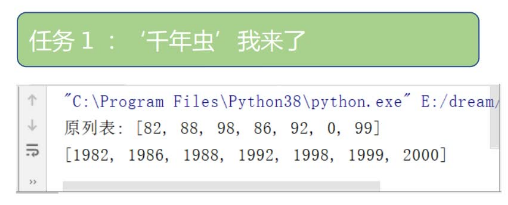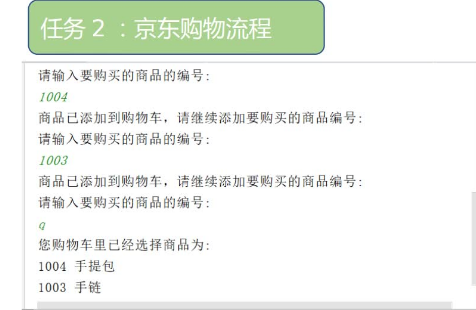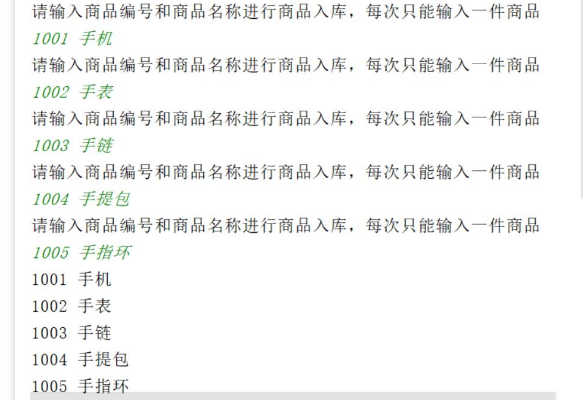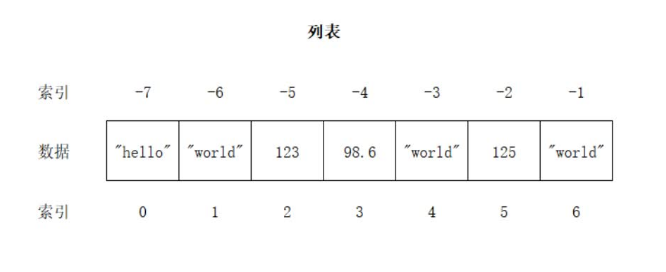Say nothing but applause!

Applause is the feeling in my heart that blogging every day is really awesome

Luckily I don't have any fans, no one rushes, just lazy! Hahaha, write the third article
----------------------------------------------------------------------------------------------------------------------
Chapter V
The main point is cycle (I find this chapter interesting personally)
- Built-in function range
- range(stop), for example range(10), is 1-9, run once, step 1
- range(start,stop), for example range(2,8), is 2-7, run once, step 1
- range(start,stop,step), for example range(3,10,2), is 3-9, run once, step interval 2. 3.5.7.9 This
- The return value is an iterator object
Look This is absolute! Easy to understand
This is absolute! Easy to understand

-
-
#Three ways to create range() '''First, there is only one parameter (only one number is given in parentheses)''' r=range(10) #[0, 1, 2, 3, 4, 5, 6, 7, 8, 9], default start at 0, default difference of 1 is called step print(r) #range(0, 10) print(list(r)) #Integer sequence used to view range objects -->list means list '''The second is created by giving two parameters (two numbers in parentheses)''' r=range(1,10) #A starting value is specified, starting at 1 and ending at 10 (excluding 10), with a default step of 1 print(list(r)) #[1, 2, 3, 4, 5, 6, 7, 8, 9] '''The third way is to give three parameters (three numbers in parentheses)''' r=range(1,10,2) print(list(r)) #[1, 3, 5, 7, 9] '''Determines whether the specified integer exists in the sequence in ,not in''' print(10 in r) #False, 10 is not in the current r integer sequence print(9 in r) #True,9 is in the relative r sequence
-
The loop structure while and for-in
- Difference between if of selection structure and while of loop structure
- if is judgement once, condition is True to execute a line
- while is the judgment N+1, if True executes N times (the last N+1 is exit)
while loop:

for-in loop:
- The in expression takes values from (strings, sequences, etc.) in turn, also known as traversal
- Objects traversed by for-in must be iterative
- for custom variable in iterative object:
- Circulatory body
- Custom variables do not need to be accessed within a loop, they can be replaced with underscores.
break statement
- Used to end a loop structure, usually with branch structure if
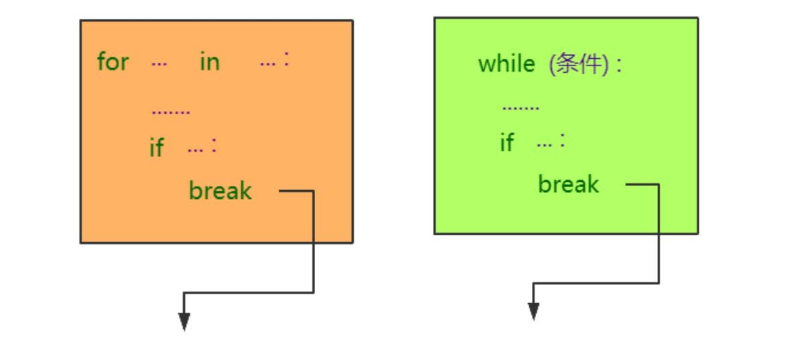
continue Statement
- Used to end the current loop and move to the next one, usually with if in a branch structure

Watch the horse Everyone
Everyone
for i in range(5): #Represents an outer loop to be executed five times
for j in range(1,11): #Do 1 to 10
if j%2==0:
#break
continue #Continue when j is divided by the remainder of 2
print(j,end='\t') #end=no line break'\t'is the tab key
print()else statement
Drive~
'Like the previous questions, it's easy to do this function'
for _ in range(3):
mima=input('Please input a password') #input outputs a string, followed by a string
if mima=='123':
print('Password is correct')
break #End
else:
print('Incorrect password') #The first pass is 0. The second pass is 1. The third pass is 2
else:
print('Sorry, the password was entered incorrectly three times')Do it!

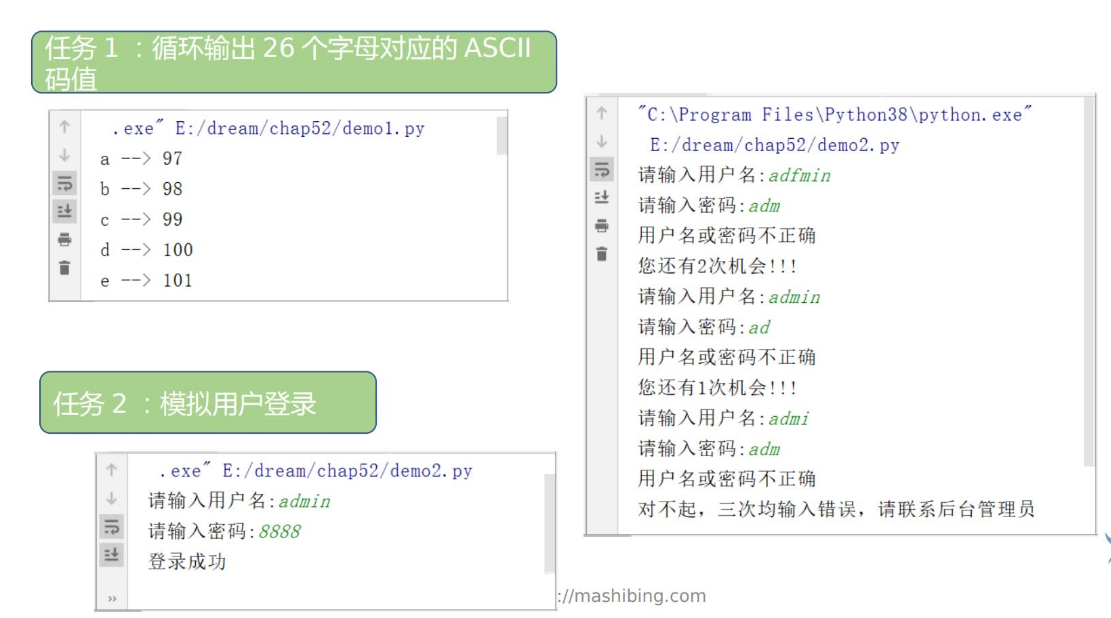
'Topic 1'
for it in range(97,123):
print(ord(it))
'Question 2'
name=input('enter one user name')
pwd=int(input('Please input a password'))
n=3
for _ in range(2):
if name=='admin' and pwd==8888:
print('Landing Success')
break
else:
n-=1
print('Username or password incorrect\n You still have'+str(n)+'Second chance!!')
name=input('enter one user name')
pwd=int(input('Please input a password'))
else:
print('Sorry, three typing errors')Chapter VI
list
Lists need brackets [], with elements separated by English commas
List built-in function list()
- lst=list(['Saint','Sauvignon'])
Features of lists
- The elements of the list are arranged in order
- Index unique data
- Can store duplicate data
- Any data type can exist
- Dynamically allocate and reclaim memory as needed
Notice in the figure below that the number starts at 0 and the negative side starts at -1
List Query
- index() Gets the specified element index
- If the same element exists, only the first index is returned
- If this element is not present, a ValueError will appear
- You can also check between points
- Get Elements
- Forward index is from 0 to N-1, which is followed by a number minus one
- Reverse index is full-N to-1
- Throw IndexError if the specified index does not exist
- Get multiple elements: list name [strat:stop:step]
- Section
- The result is a copy of the original fragment
- Scope in [strat,stop)
- The default step number is 1, which can be abbreviated [start:stop]
- When step is positive
- [: stop:step], default from the first one after going
- [start::step], default from go-back to end-last
- When step is negative
- [: stop:step], default from the first forward
- [start::step], default from back to front to last
- Section
Traverse through list elements:
- for iteration variable in list name
List Element Increase
- append(), add an element to the end of the list
- extend(), add at least one element to the end of the list
- insert(), which adds an element anywhere in the list
- Slice, adding at least one element anywhere in the list
List element deletion
- remove()
- Delete one element at a time
- Duplicate elements delete only the first
- Element does not exist throw ValueError
- pop()
- Delete an element at a specified index location
- Specified index does not exist throwing IndexError
- Delete the last element in the list without specifying an index
- Section
- Delete at least one element at a time
- clear(), empty list
- del, delete list
sort list
- With sort(), the default elements are sorted from smallest to largest (reverse=False) in ascending order and sort(reverse=Ture) in descending order
List Generation
- [i*i for i in range(1,10)]
Brain burning link, done a problem
